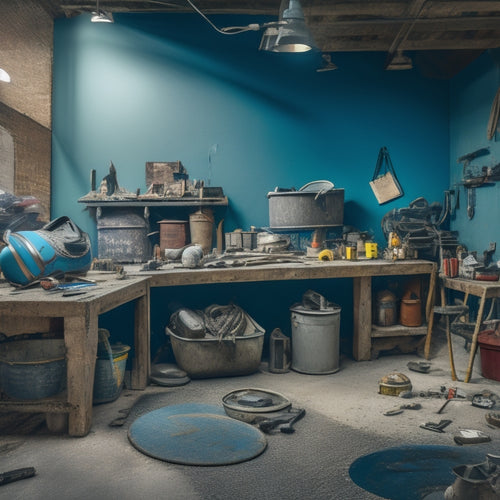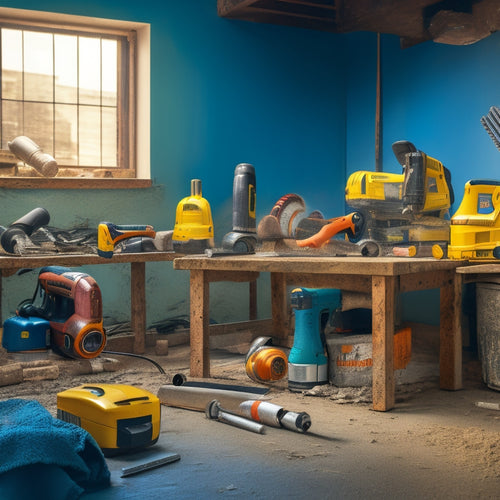
Top Tools for Concrete Block Landscaping Success
Share
To achieve concrete block landscaping success, you'll need a solid foundation of essential tools, including a sturdy level, rubber mallet, and block splitter. Measuring and marking tools like a tape measure, chalk line reel, and laser level will guarantee accuracy. Cutting and shaping tools, such as a diamond blade saw and masonry saw, will make precise cuts. For mixing and laying mortar, you'll need to balance your mix ratio and use the right trowel technique. Finally, finishing and sealing tools like a jointing tool, finishing broom, and sealing products will complete your project. Now that you have the right tools, it's time to master the techniques that bring them all together.
Key Takeaways
• A sturdy level ensures proper alignment of blocks, guaranteeing a strong and stable structure.
• A rubber mallet is essential for tapping blocks into place without damaging them.
• A block splitter is necessary for cutting blocks to required sizes, allowing for precise fitting.
• A pointing trowel fills gaps and smooths mortar joints, creating a professional finish.
• A jointer tool achieves smooth, even joints, adding to the overall aesthetic appeal of the landscape.
Essential Tools for Block Laying
You'll need a mix of manual and power tools to efficiently lay concrete blocks, starting with a sturdy level to guarantee your blocks are properly aligned and a rubber mallet to tap them into place.
A spirit level will help you achieve perfect horizontal and vertical alignment, ensuring your block wall aesthetics are unmatched.
Next, you'll require a reliable block splitter or guillotine to cut blocks to size, along with a wire brush to remove excess mortar and a pointing trowel to fill gaps.
To achieve smooth, even joints, a jointer or jointing tool is essential.
When it comes to block laying techniques, a screed board or screed trowel will help you achieve a level surface and perfect joints.
Don't forget a bucket or mixing tray to prepare your mortar, and a tamping tool to compact the mixture.
Measuring and Marking Tools
With precision being paramount in concrete block landscaping, a set of measuring and marking tools is essential for accurately evaluating block dimensions, marking cut lines, and guaranteeing uniform spacing.
You'll need a reliable tape measure to take precise measurements of your blocks, walls, and excavated areas. A 25-foot or 30-foot tape measure should suffice for most projects.
When it comes to marking cut lines, a chalk line reel is a must-have. This tool allows you to snap a straight line across multiple blocks, assuring accurate cuts and precise fits. Don't settle for a flimsy, low-quality chalk line that can break easily; invest in a heavy-duty reel that can withstand the demands of your project.
Additionally, consider a laser level or a precision leveling tool to guarantee your walls are perfectly level and plumb. These tools will help you detect even the slightest deviations, allowing you to make adjustments before they become major issues.
Cutting and Shaping Tools
A diamond blade saw or a masonry saw is your go-to tool for making precise cuts in concrete blocks, allowing you to slice through even the toughest materials with ease and accuracy.
These powerful tools are essential for cutting concrete blocks to fit around corners, curves, or other unique landscape features.
When operating a diamond blade saw or masonry saw, it's vital to wear proper safety equipment, including gloves, safety glasses, and a dust mask to protect yourself from debris and dust.
To guarantee peak performance and extend the life of your cutting tools, you'll need to implement regular maintenance techniques. This includes:
-
Regularly cleaning the saw blade to prevent buildup of concrete residue
-
Lubricating the blade to reduce friction and heat buildup
-
Storing the saw in a dry, protected area to prevent rust and corrosion
Mixing and Laying Mortar
Mixing and laying mortar accurately is essential to creating a sturdy concrete block landscape, as it bonds the blocks together and provides structural integrity.
You'll want to master the art of mixing and laying mortar to guarantee your concrete block landscape stands the test of time. To achieve the perfect mix, you'll need to balance the ratio of cement, sand, and water. Start by adding the cement and sand to the mixing bucket, then gradually add water while mixing. Aim for a consistency similar to thick peanut butter. To test the mix, squeeze a small amount between your thumb and index finger; if it holds its shape, it's ready.
When laying the mortar, use a level to guarantee the blocks are straight and a trowel to spread the mortar evenly. Hold the trowel at a 45-degree angle and press the mortar firmly into the joints. Use a pointing trowel to fill in the gaps and smooth out the excess.
Remember to work in small sections, about 3-4 blocks at a time, to maintain even mortar consistency. By mastering these mixing and laying techniques, you'll be well on your way to creating a concrete block landscape that's both functional and visually stunning.
Finishing and Sealing Tools
You'll now reach for specialized finishing and sealing tools to protect your concrete block landscape from the elements and enhance its visual appeal. These tools will help you achieve a professional-looking finish and guarantee your landscape stands the test of time.
When it comes to finishing techniques, you'll need the right tools to get the job done. Here are a few essentials to add to your arsenal:
-
A jointing tool, such as a jointer or trowel, to create clean, defined joints between blocks
-
A finishing broom, with stiff bristles, to create a textured finish and remove excess mortar
-
An edger, to create a clean, defined edge along sidewalks, patios, and other hardscapes
Once you've achieved the desired finish, it's time to seal your concrete block landscape with high-quality sealing products. These products will protect your landscape from water, stains, and UV damage, while also enhancing its color and appearance.
Look for sealing products specifically designed for concrete block and follow the manufacturer's instructions for application and maintenance. With the right finishing and sealing tools, you'll be able to achieve a stunning, long-lasting concrete block landscape that will elevate your outdoor space.
Frequently Asked Questions
How Do I Prevent Efflorescence on My Concrete Block Walls?
You're wise to worry about efflorescence on your concrete block walls!
It's a common issue caused by water seeping through the blocks and bringing salts to the surface.
To prevent it, you'll need to block the water's path.
Apply a waterproofing membrane to the blocks before construction, and guarantee good drainage by sloping the wall slightly.
Also, use a silane-based sealer to repel water and reduce efflorescence causes.
With these prevention techniques, you'll keep your walls looking fresh and salt-free.
Can I Use Concrete Blocks for Building a Retaining Wall?
When building a retaining wall, you're likely wondering if concrete blocks are a viable option. The answer is yes!
With proper block wall design, you can create a sturdy structure that withstands soil pressure.
Retaining wall advantages include improved drainage, increased stability, and enhanced aesthetics.
By using concrete blocks, you'll benefit from their durability and low maintenance requirements.
Just make sure you follow local building codes and consult with a professional if needed.
What Is the Ideal Drainage System for Concrete Block Landscaping?
When designing a concrete block landscape, you'll want to prioritize a robust drainage system to prevent water accumulation.
You'll need to implement effective drainage techniques, such as installing French drains or permeable pavers, to guarantee proper water management.
This will prevent erosion, reduce maintenance, and create a stable structure.
How Do I Achieve a Uniform Color for My Concrete Blocks?
To achieve a uniform color for your concrete blocks, you'll want to master color mixing and staining techniques.
Start by selecting a high-quality, UV-resistant stain that complements your design.
Next, prepare a controlled environment for staining, ensuring consistent temperature and humidity.
Mix stains in small batches, following the manufacturer's instructions, and apply them uniformly using a low-pressure sprayer or lambswool applicator.
Are Concrete Blocks Suitable for Building a Fire Pit or Outdoor Oven?
When building a fire pit or outdoor oven, you're likely wondering if concrete blocks are up to the task. The answer is yes, but with caveats.
You'll need to guarantee proper fire pit design and outdoor oven construction, including refractory materials and insulation to withstand high temperatures.
Additionally, consider using high-heat-resistant concrete blocks or refractory concrete to prevent damage.
With careful planning and execution, concrete blocks can be a great choice for your outdoor cooking project.
Conclusion
As you stand back to admire your finished concrete block landscape, the precision and beauty of your work stands in stark contrast to the rough, unyielding blocks that lay scattered on the ground just hours before.
Your toolkit, once a jumble of unfamiliar instruments, now lies neatly organized, each tool a demonstration to the essential role it played in transforming raw materials into a work of art.
With the right tools, the impossible becomes possible, and your vision takes shape.
Related Posts
-

7 Must-Have Tools for Concrete Repair Organization
To effectively organize your concrete repair projects, you'll need a thorough toolkit that includes a well-planned st...
-

What Tools Do You Need for Concrete Flooring
You'll need a thorough arsenal of specialized tools to achieve a high-quality, professional-looking concrete floor, i...
-

Essential Power Tools for Concrete Block Construction
When building with concrete blocks, you'll need a range of power tools to cut, drill, mix, and finish the blocks to g...


